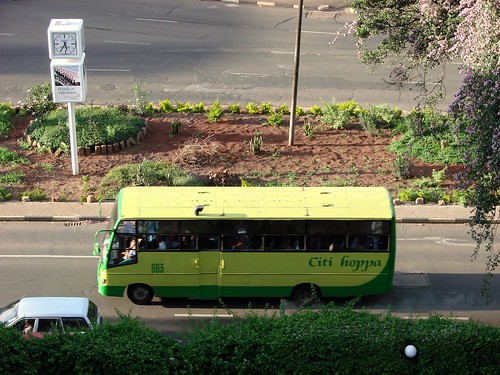14 seater -
 or 29 seater.
or 29 seater. The Muthurwa bus terminal problem with its 3000 odd matatu's could be easily solved by getting bigger buses with capacities of up to 190 passengers. These buses should be low to allow those of us who are getting old to get into them.
The Muthurwa bus terminal problem with its 3000 odd matatu's could be easily solved by getting bigger buses with capacities of up to 190 passengers. These buses should be low to allow those of us who are getting old to get into them.I find the Citi-Hoppa's, Double M's and KBS'es too high for comfort that I am always afraid that they would topple over when over speeding round a corner (most citi hoppa buses have disabled their speed governors!) or I would fall off while alighting through their narrow high doors.
The buses should look something like this:
 Or on high volume routes like the Eastlands one the buses should be the articulated ones.
Or on high volume routes like the Eastlands one the buses should be the articulated ones. There are many advantages of using such buses. Not only do they have a lifetime of about 12 years when properly maintained but there is a possibility to have them running on natural gas or have hybrid ones running on both diesel and electricity - they can have batteries or have connections to electric pylons on designated routes.
There are many advantages of using such buses. Not only do they have a lifetime of about 12 years when properly maintained but there is a possibility to have them running on natural gas or have hybrid ones running on both diesel and electricity - they can have batteries or have connections to electric pylons on designated routes.To get them the Michuki rules will have to be revised to not apply to these buses, since most of the passengers will be standing as one can see from the bottom pic depicting the standard interior of such a bus.

Anyway I haven't witnessed this in a long while and hope that we do not go back there any time soon!


Good comments. Keep in mind,the costs of producing these buses is significantly higher. Theretail price would be out of reach of many entreprenuers. And for those that can afford these, the buses would have to work at a higher frequency, and higher volumes to produce enough cashflows to cover operating expenses (will be low to star, since new, but as they age, this will be substantial) and financing expenses (if fianced by banks). In the current market, where they would compete against cheaper, mathrees, they may have a had time competing. Anyway,
ReplyDeletemy two ndururu's.
Good idea to have buses but these must have enough space to get around. They way some of the roads and roundabouts in Nairobi are built, articulated and bi-articulated buses in numbers high enough would end up adding to the congestion rather than alleviating it.
ReplyDeleteIn addition to these, there should be a rezoning of the city with say, Moi Avenue becoming a one way multi-passenger vehicle street etc.
The city should also finally build the city bypass roads that they have been touting for years (Mr Prime Minister please) and encourage carriers to bridge routes across the city e.g. (Buru buru to Westlands) rather than terminating in the city.
Finally, a standardization of fares and ticketing should be implemented to speed up passenger processing, revenue collection and passenger safety. If all I am carrying on a typical weekday is my sandwich, credit card and bus tokens, what do thieves and pickpockets expect to get from me? Also, touts would no longer need to handle money adding to safety on the roads and (tongue in cheek) cleaner notes and coins all round.
I think a multi-phased approach to the problem needs to be thought up and implemented.
foodmerchant: I think the issue of cost is something which can be solved. I still think it would be cheaper to transport more people at once in bigger buses than in the smaller matatu's which have to make more trips. Its the same issue that cargo haulers have with the 4axle (more cargo on one trip) vs 3axle (less cargo) trucks. These guys this days afford to get mercede actros trucks which are not cheap.
ReplyDeleteThe only thing against buses are the rising fuel costs. Anyway buses are better placed to be of hybrid type than mathrees.
bambi: yes I agree the infrastructure has to be fixed to allow the articulated buses to operate. They have a turning circle of about 22m...a station wagon has about 14m!
I don't disagree that it would be cheaper/more cost efficient to operate bigger buses. The costs of aquring these would be higher, and while some can afford it, most small entrepreniers would be hard pressed finance them.
ReplyDeleteHello, I do not agree with the previous commentator - not so simple
ReplyDelete